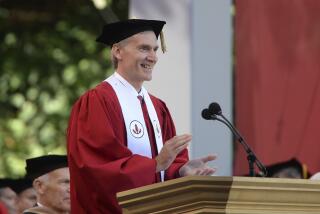Journal Is Giving Science Back to the People
The inaugural issue of a new scientific publication appeared online today, its pages brimming with studies on elephants, biological clocks and thought-controlled robotic arms. Its publishers are hoping it will spark a revolution.
The journal, Public Library of Science Biology, can be read, downloaded and copied free by anyone with Internet access -- distinguishing it from the vast majority of scientific journals, which charge annual subscription fees that can run into the thousands of dollars.
Scientists, librarians, charitable foundations and patient groups expressed support for the fledgling publication as an alternative to journals such as Nature and Cell, which charge significant subscription fees. Some journals -- such as the organic chemistry publication Tetrahedron Letters, costing $11,000 a year -- are a substantial burden for university libraries.
Many view such costs as unfair, complaining that science, generally paid for with public money, should not have to be bought back to be shared.
“The public pays for most of this research one way or another,” said Steven Koonin, provost of Caltech and a professor of theoretical physics. “For someone to be locking it up with high prices and copyright restrictions just does not seem right.”
California scientist Michael Eisen, a cofounder of PLoS Biology, added: “We’re getting a raw deal.”
The San Francisco-based, nonprofit Public Library of Science (www.plos.org) is the brainchild of Nobel laureate Harold E. Varmus, molecular biologist Patrick O. Brown of Stanford University and Eisen, a biology professor at UC Berkeley and scientist at Lawrence Berkeley National Laboratory.
The trio’s dream: a world in which the many thousands of scientific journals -- from Advances in Internal Medicine to Zoology -- are placed in an electronic library open to the public.
Varmus, Brown and Eisen have spent years trying to persuade scientific publishers to make such access possible.
Several years ago, they circulated a letter calling for change, which was signed by over 30,000 scientists. The scientists who signed promised to publish only in journals that provided open access to articles within six months of publication.
Most journals refused to change their practices, and the campaign fizzled. Varmus and his colleagues finally decided the only solution was to publish their own scientific journals.
With a start-up grant of $9 million from the Gordon and Betty Moore Foundation and the Irving A. Hansen Memorial Foundation, they drew up a business plan and hired editors, some wooed from leading for-profit publications.
Today’s launch of PLoS Biology will be followed next year by the launch of PLoS Medicine. Eventually, the library will publish a variety of journals covering other areas of science, said Varmus, former chief of the National Institutes of Health.
“Patients will be delighted to have that kind of easy access to the scientific literature and ... this will only help in the cross-fertilization of ideas,” said Susan Howley, director of research at the Christopher Reeve Paralysis Foundation.
While there are other open-access online journals, the goal is to make the PLoS series as prestigious and respected as journals such as Science, Nature and Cell, publications that scientists yearn to be published in.
To cover salaries, publishing expenses and the costs of peer-reviewing articles, PLoS Biology has changed the traditional publishing business model. Instead of charging readers, it charges scientists $1,500 to publish a paper. It will also charge $160 a year for a subscription to the print version of the journal.
Some scientists and publishers expressed doubts about the Public Library business model.
Alan Leshner, chief executive officer of the American Assn. for the Advancement of Science and executive publisher of the nonprofit journal Science, said: “The goal is a good one. The question is: Can they make it work?”
Leshner said he doubted Science, which employs a large news staff, could make ends meet without subscription fees.
Eric Merkel-Sobotta, director of corporate relations for Amsterdam-based Elsevier, the world’s largest for-profit publisher of scientific journals, said: “We don’t think it’s a sustainable business model.”
Elsevier publishes over 1,800 scientific titles, including some of the world’s most expensive. One package of seven Elsevier journals concerning brain research costs over $20,000 a year.
Merkel-Sobotta said that the PLoS campaign simplistically depicts the publishers as money-grubbers. Elsevier supplies free journals to developing nations through a World Health Organization program and bears the financial burden of archiving its journals, he said.
One of the biggest hurdles for the PLoS effort will be convincing scientists that the Public Library journals are prestigious places to publish.
Michael Rosbash, a molecular geneticist at Brandeis University in Waltham, Mass., said his graduate student Ying Peng was glad to have his first research paper (on biological clocks in fruit flies) published in PLoS Biology’s inaugural issue. “He’s for it politically,” Rosbash said.
Dr. Miguel Nicolelis, a Duke University neurobiologist, also published in the inaugural issue. His study showed that a single brain region in monkeys can be trained to control a robotic arm -- a finding with significant implications for patients with paralysis.
“I think it’s very important to support this. That’s why we decided to send such a high-profile study to them -- to show our unconditional support for open access,” Nicolelis said.






